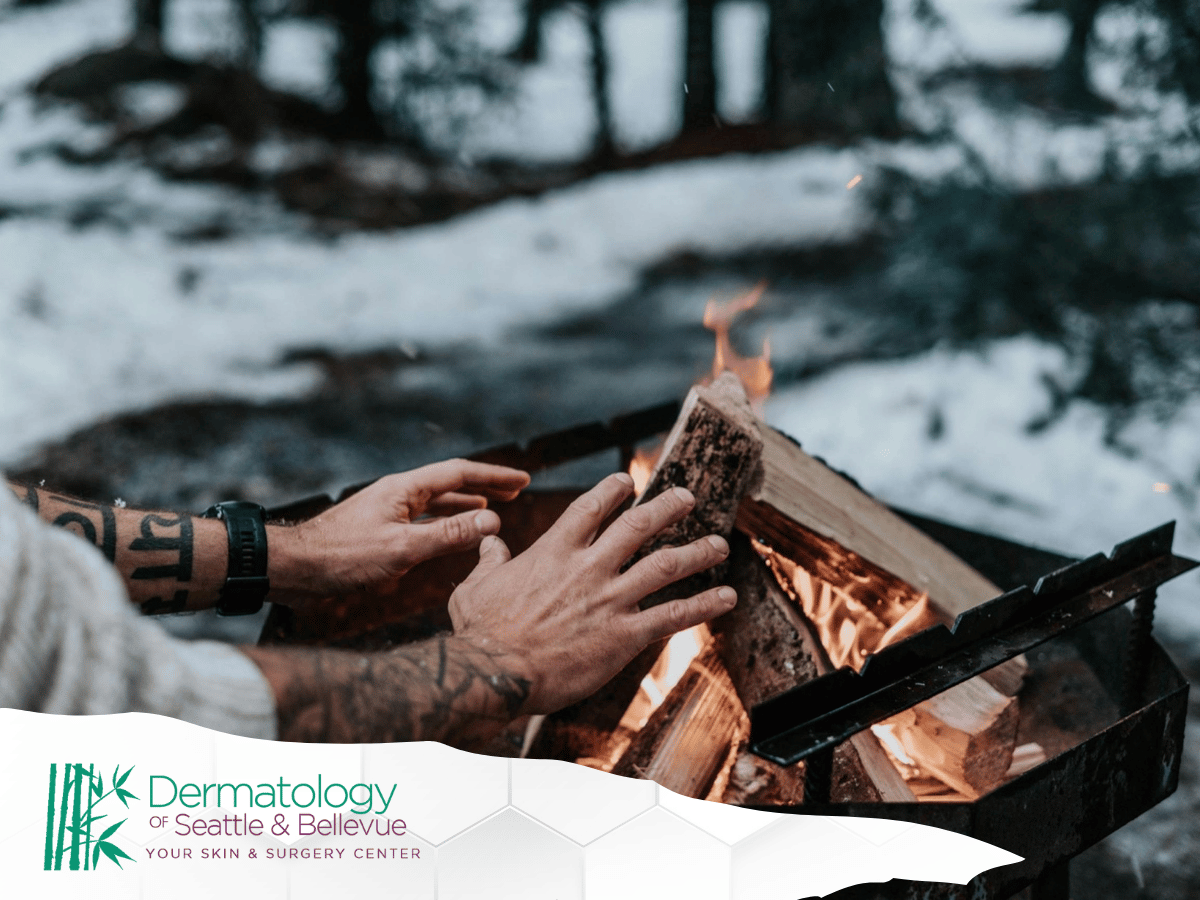Introduction
Cold weather brings cozy sweaters, hot drinks, and—for many—cracked, itchy hands. Winter hand dermatitis is one of the most common skin complaints in the Pacific Northwest, especially around Bellevue, where chilly, damp air and frequent handwashing can strip the skin’s natural barrier. Understanding what causes this seasonal irritation and how to treat it effectively can help you keep your hands healthy all year.
What is winter hand dermatitis?
Winter hand dermatitis is a form of eczema that flares up when the skin loses too much moisture. The result is redness, itching, flaking, and sometimes painful fissures on the fingers and palms. While it often improves in warmer months, consistent winter skin care is essential to prevent recurring irritation.
It’s not just about dryness—factors like repeated exposure to soaps, sanitizers, and allergens can make the skin more sensitive and prone to inflammation.
Why is it more prevalent in winter?
Cold air holds less humidity, and when combined with indoor heating, it quickly dries out the skin. In Bellevue’s damp but cool climate, people often use hot water and strong cleansers to stay warm and clean—both of which damage the skin’s protective layer.
This disruption allows irritants to penetrate more easily, leading to dry skin relief struggles that seem endless through the colder months. Wearing gloves, applying moisturizer immediately after washing, and avoiding harsh detergents can make a noticeable difference.
Brief overview of clinic-backed treatments
Modern dermatology offers multiple clinic-backed treatments to manage winter hand dermatitis effectively. These may include:
- Topical corticosteroids to reduce inflammation and itching.
- Prescription-strength moisturizers to rebuild the skin barrier.
- Identifying and treating allergic contact dermatitis triggers.
Dermatologists in Bellevue often combine medical therapy with lifestyle adjustments, ensuring a comprehensive approach to hand eczema solutions that actually work.
Understanding the Types of Dermatitis
Winter hand dermatitis can have more than one cause, and understanding which type you’re dealing with helps ensure the right treatment. Dermatologists in Bellevue frequently diagnose a mix of allergic contact dermatitis, irritant contact dermatitis, and hand eczema—each with its own triggers and management strategies.
Knowing the difference can prevent unnecessary discomfort and help you take targeted steps toward healing.
Allergic contact dermatitis
This type of dermatitis happens when your skin reacts to a specific allergen. Common culprits include fragrances, preservatives in lotions, metals like nickel, and certain cleaning products. Even a small amount of exposure can trigger redness, itching, and swelling.
Dermatologists may recommend patch testing to identify your triggers and then guide you toward gentler alternatives. Avoidance, paired with topical corticosteroids, can bring significant relief once the offending substance is removed.
Irritant contact dermatitis
Unlike allergic dermatitis, this condition isn’t about sensitivity—it’s about overexposure. Frequent handwashing, dishwashing, and sanitizing break down the skin’s natural oils, causing cracks and inflammation. The result? Burning, roughness, and persistent dryness.
To prevent flare-ups, it’s vital to limit exposure to harsh soaps, wear gloves for cleaning, and reapply a moisturizing hand cream regularly throughout the day.
Hand eczema solutions
When dermatitis becomes chronic or severe, standard over-the-counter creams may not be enough. A dermatologist may prescribe stronger topical medications or even short-term oral treatments to control inflammation.
Some effective hand eczema solutions include:
- Fragrance-free, ceramide-rich creams to restore moisture.
- Barrier-repair ointments used under cotton gloves overnight.
- Personalized treatment plans for flare-up prevention.
Combining these methods can help rebuild skin resilience during Bellevue’s long, cold winters.
Effective Treatments for Winter Hand Dermatitis
When dryness turns painful or persistent, professional-grade care can make all the difference. The goal of any treatment plan is twofold—repair the skin barrier and reduce inflammation. Dermatologists in Bellevue often combine medicated creams, barrier ointments, and lifestyle recommendations to achieve fast, lasting results.
These clinic-backed treatments are designed not just to relieve symptoms but to strengthen your skin for the long term.
Topical corticosteroids
Topical corticosteroids are among the most trusted medical treatments for winter hand dermatitis.
How they work:
These creams or ointments reduce inflammation, soothe itching, and calm redness by suppressing the immune response that drives irritation. They’re available in different strengths, from mild over-the-counter options to prescription-only formulas.
When to use them:
They’re typically applied once or twice daily for short periods during flare-ups. Your dermatologist will guide you on the right potency and duration—overuse can thin the skin, so professional oversight is key.
Moisturizing hand cream
Moisturizers are the backbone of any winter skin care routine. A good moisturizing hand cream keeps water locked in and prevents further irritation.
Key ingredients to look for:
- Ceramides for barrier repair
- Glycerin or hyaluronic acid for deep hydration
- Shea butter or petrolatum for protection
Application techniques:
Apply cream immediately after washing and before bed to trap moisture. Keep a small tube at work, in your bag, or by the sink so it’s always within reach—consistency is what transforms temporary relief into lasting comfort.
Practical Winter Skin Care Tips
Beyond medical treatments, daily habits can make or break your progress with hand dermatitis. The Pacific Northwest’s cold, damp air requires a thoughtful approach to winter skin care, emphasizing protection, hydration, and barrier repair.
Here’s how to keep your hands comfortable, even during Bellevue’s coldest months.
Daily skin care routines
A gentle routine is your best defense. Replace harsh soaps with mild, fragrance-free cleansers and always follow with a thick layer of moisturizing hand cream. Limit hot water exposure—it can worsen dryness—and instead opt for lukewarm washing.
Building consistency is key. Over time, your skin’s protective barrier will grow stronger, making flare-ups less frequent.
Importance of hydration
Hydration plays a bigger role than most realize in preventing dermatitis. Moisturizing from the outside helps, but your skin also needs support from within.
Drinking water vs. moisturizing:
While staying hydrated benefits your overall health, topical moisturizers directly address the problem of water loss from the skin’s surface. The best results come from combining both habits—drink enough water daily and apply cream after each wash.
Protective measures against the cold
Even the most advanced hand eczema solutions can’t help if your skin is constantly exposed to cold and wind. Simple protective measures can prevent future irritation and cracking.
- Wear insulated gloves when outdoors.
- Use cotton liners under rubber gloves when cleaning.
- Avoid direct contact with snow, ice, or harsh chemicals.
By maintaining these habits, you’ll protect the progress made through clinic-backed treatments and ensure lasting dry skin relief.
When to Consult a Specialist
Sometimes, even the best home remedies and over-the-counter creams aren’t enough. If your hands stay red, cracked, or painful for more than two weeks despite diligent care, it’s time to see a dermatologist. Bellevue-area clinics specialize in identifying underlying causes like allergic contact dermatitis or chronic eczema that may need prescription treatment.
Professional evaluation ensures you’re not overlooking infections or other skin conditions that mimic dermatitis.
Signs your dermatitis needs professional care
You should book an appointment if you notice any of the following:
- Persistent itching, bleeding, or cracking
- Oozing or yellow crusts that could indicate infection
- Pain that interferes with sleep or daily tasks
- No improvement after using topical corticosteroids or moisturizers
A dermatologist can adjust your treatment plan or suggest advanced options such as light therapy or prescription immunomodulators.
Long-term management strategies
Managing winter hand dermatitis often requires ongoing attention, not just quick fixes. Long-term strategies include identifying personal triggers, following a consistent moisturizing hand cream regimen, and scheduling routine skin checks.
Dermatologists in Bellevue may also recommend mole mapping or full skin exams for patients with sensitive or allergy-prone skin, ensuring overall skin health year-round.
Conclusion
Winter doesn’t have to mean sore, chapped hands. With the right combination of medical treatments, protective habits, and consistent care, you can enjoy soft, healthy skin even through the coldest Bellevue days.
Dermatology of Seattle & Bellevue provides tailored care for chronic hand dermatitis, eczema, and other skin conditions—backed by proven results and compassionate expertise.
Disclaimer
This article is for informational purposes only and should not replace medical advice. Always consult a licensed dermatologist for personalized diagnosis and treatment.








